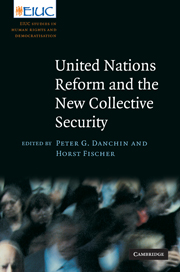Book contents
- Frontmatter
- Contents
- List of contributors
- Series editors' preface
- Preface
- List of abbreviations
- Introduction: the new collective security
- PART I Law and politics in United Nations reform
- PART II Defining “threats” to collective security
- 4 Assessing the High-Level Panel Report: rethinking the causes and consequences of threats to collective security
- 5 Collective security and the responsibility to protect
- 6 Responses to nonmilitary threats: environment, disease, and technology
- PART III Prevention and responses
- PART IV Perspectives on the ground
- Bibliography
- Index
5 - Collective security and the responsibility to protect
from PART II - Defining “threats” to collective security
Published online by Cambridge University Press: 05 May 2010
- Frontmatter
- Contents
- List of contributors
- Series editors' preface
- Preface
- List of abbreviations
- Introduction: the new collective security
- PART I Law and politics in United Nations reform
- PART II Defining “threats” to collective security
- 4 Assessing the High-Level Panel Report: rethinking the causes and consequences of threats to collective security
- 5 Collective security and the responsibility to protect
- 6 Responses to nonmilitary threats: environment, disease, and technology
- PART III Prevention and responses
- PART IV Perspectives on the ground
- Bibliography
- Index
Summary
Is the concept of collective security viable? To its critics, as well as to some of its supporters, the requirements for its realization are so formidable as to render the concept deeply flawed, or unable to provide “a workable and acceptable means” to achieve peace and order in the international system. Yet collective security has demonstrated considerable resilience in the face of many post-Cold War challenges that include a progressive expansion of “threats to the peace” as well as the means to address such threats.
The US-led global “war on terror” has added another layer of complexity to collective security's predicament. The ensuing discussion on the unilateral use of force has strained collective understandings of the relevant provisions of the UN Charter and has reinforced communal concerns about growing power asymmetries. In the fall of 2003, in the midst of an unfolding crisis, then Secretary-General Kofi Annan stated in his address to the General Assembly that the international community had reached a “fork in the road” necessitating tough questions “about the adequacy, and effectiveness, of the rules and instruments at our disposal.” In that same speech, Annan indicated his decision to establish a High-Level Panel which, among other things, would “examine the current challenges to peace and security,” “consider the contribution which collective action can make in addressing these challenges,” and “recommend ways of strengthening the United Nations, through reform of its institutions and processes.” In December 2004, the High-Level Panel issued its report entitled A More Secure World.
- Type
- Chapter
- Information
- United Nations Reform and the New Collective Security , pp. 155 - 172Publisher: Cambridge University PressPrint publication year: 2010
- 2
- Cited by



